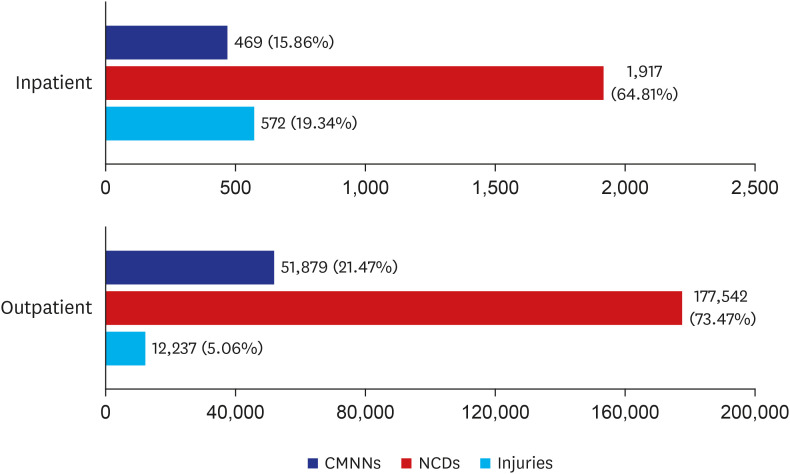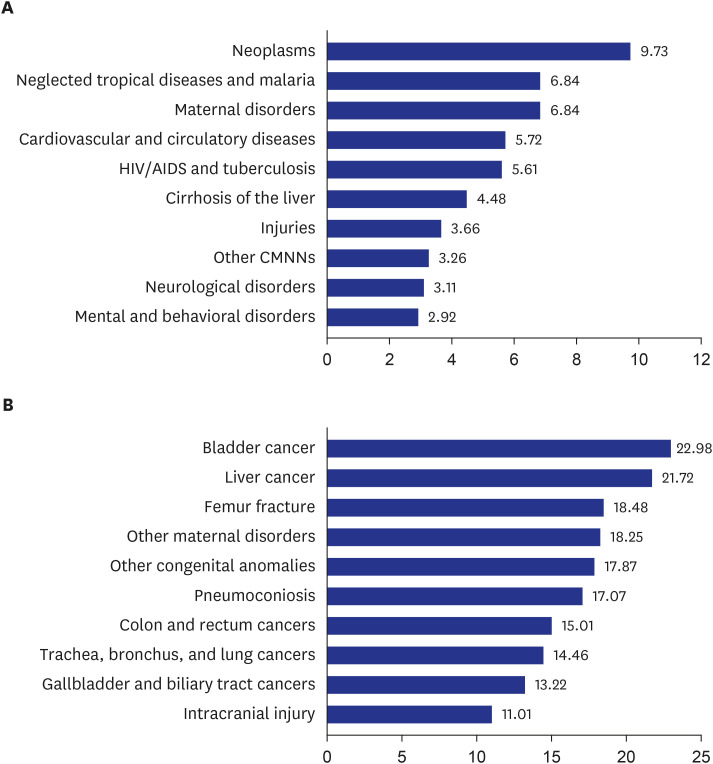J Korean Med Sci.
2020 Sep;35(35):e290. 10.3346/jkms.2020.35.e290.
Influencing Factors of Transportation Costs Regarding Healthcare Service Utilization in Korea
- Affiliations
-
- 1Department of Preventive Medicine, School of Medicine, Kyung Hee University, Seoul, Korea
- KMID: 2506086
- DOI: http://doi.org/10.3346/jkms.2020.35.e290
Abstract
- Background
Transportation costs can be a barrier to healthcare services, especially for low-income, disabled, elderly, and geographically isolated populations. This study aimed to estimate the transportation costs of healthcare service utilization and related influencing factors in Korea in 2016.
Methods
Transportation costs were calculated using data from the 2016 Korea Health Panel Study. A total of 14,845 participants were included (males, 45.07%; females, 54.93%), among which 2,148 participants used inpatient and 14,787 used outpatient care services. Transportation costs were estimated by healthcare types, transportation modes, and all disease and injury groups that caused healthcare service utilization. The influencing factors of higher transportation costs were analyzed using multivariable regression analysis.
Results
In 2016, the average transportation costs were United States dollars (USD) 43.70 (purchasing power parity [PPP], USD 32.35) per year and USD 27.67 (PPP, USD 20.48) per visit for inpatient care; for outpatient case, costs were USD 41.43 (PPP, USD 30.67) per year and USD 2.09 (PPP, USD 1.55) per visit. Among disease and injury groups, those with neoplasms incurred the highest transportation costs of USD 9.73 (PPP, USD 7.20). Both inpatient and outpatient annual transportation costs were higher among severely disabled individuals (inpatient, +USD 44.71; outpatient, +USD 23.73) and rural residents (inpatient, +USD 20.40; outpatient, +USD 28.66). Transportation costs per healthcare visit were influenced by healthcare coverage and residential area. Sex, age, and income were influencing factors of higher transportation costs for outpatient care.
Conclusion
Transportation cost burden was especially high among those with major noncommunicable diseases (e.g., cancer) or living in rural areas, as well as elderly, severely disabled, and low-income populations. Thus, there is a need to address the socioeconomic disparities related to healthcare transportation costs in Korea by implementing targeted interventions in populations with restricted access to healthcare.
Keyword
Figure
Reference
-
1. Syed ST, Gerber BS, Sharp LK. Traveling towards disease: transportation barriers to health care access. J Community Health. 2013; 38(5):976–993. PMID: 23543372.
Article2. Wallace R, Hughes-Cromwick P, Mull H, Khasnabis S. Access to health care and nonemergency medical transportation - two missing links. Transp Res Rec. 2005; 1924(1):76–84.3. Wallace R, Hughes-Cromwick P, Mull H. Cost-effectiveness of access to nonemergency medical transportation: comparison of transportation and health care costs and benefits. Transp Res Rec. 2006; 1956(1):86–93.4. Song YJ. The South Korean health care system. Japan Med Assoc J. 2009; 52(3):206–209.5. National Health Insurance Service. 2018 National Health Insurance Statistical Yearbook. Wonju: National Health Insurance Service;2019. p. 40–41.6. Korean Statistical Information Service. Projected population by age (Korea). Updated 2019. Accessed April 16, 2020. http://kosis.kr/statHtml/statHtml.do?orgId=101&tblId=DT_1BPA001&conn_path=I2&language=en.7. Choi Y, Nam K, Kim CY. Association between convenience of transportation and unmet healthcare needs of rural elderly in Korea. J Prev Med Public Health. 2019; 52(6):355–365. PMID: 31795612.
Article8. Kim JR, Jeong B, Park KS, Kang YS. Associations of generalized trust and social participation at the individual level with unmet healthcare needs in communities with high mortality. J Korean Med Sci. 2018; 33(11):e84. PMID: 29495134.
Article9. Park JH, Lee JS, Lee JY, Hong JY, Kim SY, Kim SO, et al. Factors affecting national health insurance mass screening participation in the disabled. J Prev Med Public Health. 2006; 39(6):511–519. PMID: 17168205.10. Yoon C, Ju YS, Kim CY. Disparities in health care utilization among urban homeless in South Korea: a cross-sectional study. J Prev Med Public Health. 2011; 44(6):267–274. PMID: 22143177.
Article11. Hwang B, Chun SM, Park JH, Shin HI. Unmet healthcare needs in people with disabilities: comparison with the general population in Korea. Ann Rehabil Med. 2011; 35(5):627–635. PMID: 22506184.
Article12. Kim YA, Oh IH, Yoon SJ, Kim HJ, Seo HY, Kim EJ, et al. The economic burden of breast cancer in Korea from 2007–2010. Cancer Res Treat. 2015; 47(4):583–590. PMID: 25687860.
Article13. Kim YE, Lee YR, Park SY, Lee KS, Oh IH. The economic burden of otitis media in Korea, 2012: a nationally representative cross-sectional study. BioMed Res Int. 2016; 2016:3596261. PMID: 27703971.
Article14. Lee KS, Chang HS, Lee SM, Park EC. Economic burden of cancer in Korea during 2000-2010. Cancer Res Treat. 2015; 47(3):387–398. PMID: 25672582.
Article15. Lee YH, Yoon SJ, Kim EJ, Kim YA, Seo HY, Oh IH. Economic burden of asthma in Korea. Allergy Asthma Proc. 2011; 32(6):35–40. PMID: 22221428.
Article16. Lee YR, Cho B, Jo MW, Ock M, Lee D, Lee D, et al. Measuring the economic burden of disease and injury in Korea, 2015. J Korean Med Sci. 2019; 34(Suppl 1):e80. PMID: 30923489.
Article17. Shon C, Choi HY, Shim JJ, Park SY, Lee KS, Yoon SJ, et al. The economic burden of hepatitis A, B, and C in South Korea. Jpn J Infect Dis. 2016; 69(1):18–27. PMID: 25971325.
Article18. Hanly P, Céilleachair AÓ, Skally M, O'Leary E, Kapur K, Fitzpatrick P, et al. How much does it cost to care for survivors of colorectal cancer? Caregiver's time, travel and out-of-pocket costs. Support Care Cancer. 2013; 21(9):2583–2592. PMID: 23649879.
Article19. Leminen A, Tykkyläinen M, Laatikainen T. Self-monitoring induced savings on type 2 diabetes patients' travel and healthcare costs. Int J Med Inform. 2018; 115:120–127. PMID: 29779714.
Article20. Secker-Walker RH, Vacek PM, Hooper GJ, Plante DA, Detsky AS. Screening for breast cancer: time, travel, and out-of-pocket expenses. J Natl Cancer Inst. 1999; 91(8):702–708. PMID: 10218508.
Article21. Sørensen J, Linde L, Hetland ML. Contact frequency, travel time, and travel costs for patients with rheumatoid arthritis. Int J Rheumatol. 2014; 2014:285951. PMID: 24693288.
Article22. Stephens JM, Brotherton S, Dunning SC, Emerson LC, Gilbertson DT, Gitlin M, et al. High cost of dialysis transportation in the United States: exploring approaches to a more cost-effective delivery system. J Health Econ Outcomes Res. 2013; 1(2):134–150.23. Woolley C, Philips Z, Whynes DK, Cotton SC, Gray NM, Sharp L, et al. United Kingdom cervical cancer screening and the costs of time and travel. Int J Technol Assess Health Care. 2007; 23(2):232–239. PMID: 17493309.
Article24. Jo C. Cost-of-illness studies: concepts, scopes, and methods. Clin Mol Hepatol. 2014; 20(4):327–337. PMID: 25548737.
Article25. Korea Health Panel Study. Updated 2016. Accessed March 23, 2020. https://www.khp.re.kr:444/eng/main.do.26. Kim YE, Park H, Jo MW, Oh IH, Go DS, Jung J, et al. Trends and patterns of burden of disease and injuries in Korea using disability-adjusted life years. J Korean Med Sci. 2019; 34(Suppl 1):e75. PMID: 30923488.
Article27. Health Insurance Review & Assessment Service, National Health Insurance Service. Classification of 298 Diseases. 2018 National Health Insurance Statistical Yearbook. Wonju: National Health Insurance Service;2019. p. 428–438.28. Ministry of the Interior and Safety. Administrative districts of local governments. Information and Statistics Division. Statistical Yearbook of MOIS (Volume 21). Sejong: Ministry of the Interior and Safety;2019.29. Bank of Korea Economic Statistics System. Exchange rate of Won against US Dollar, China Yuan Renminbi, and Japan Yen, longer frequency. Updated 2020. Accessed April 8, 2020. http://ecos.bok.or.kr/.30. Organization for Economic Cooperation and Development. Stat. 4. PPPs and exchange rates. Updated 2020. Accessed July 3, 2020. https://stats.oecd.org/Index.aspx?DatasetCode=SNA_TABLE1.31. Kim N, Seo J, Jung Y, Lee J, Lee N, Bae J, et al. A Report on the Korea Health Panel Survey of 2016: Chronic Disease, Morbidity, Health Behaviour and Health Status. Sejong: Korea Institute for Health and Social Affairs;2018.32. Wang C. The impact of car ownership and public transport usage on cancer screening coverage: empirical evidence using a spatial analysis in England. J Transp Geogr. 2016; 56:15–22. PMID: 27829709.
Article33. Godavarthy RP, Mattson J, Ndembe E. Cost–benefit analysis of rural and small urban transit in the United States. Transp Res Rec. 2015; 2533(1):141–148.34. The Korea Transport Institute. Transport·SOC related Government Expense. National Transportation Statistics 2018. Sejong: The Korea Transport Institute;2019.35. Organization for Economic Cooperation and Development. Urban Transport Governance and Inclusive Development in Korea. Paris: OECD Publishing;2017.36. The Korea Transport Institute. Passenger Journeys and Total Distance Travelled on Rail/Subway/Airport Rail/Light Rail. National Transportation Statistics 2018. Sejong: The Korea Transport Institute;2019.37. Jowett S, Bryan S, Mahé I, Brieger D, Carlsson J, Kartman B, et al. A multinational investigation of time and traveling costs in attending anticoagulation clinics. Value Health. 2008; 11(2):207–212. PMID: 18380632.
Article38. Lee JY, Jo MW, Yoo WS, Kim HJ, Eun SJ. Evidence of a broken healthcare delivery system in korea: unnecessary hospital outpatient utilization among patients with a single chronic disease without complications. J Korean Med Sci. 2014; 29(12):1590–1596. PMID: 25469056.
Article39. Yoon TH, Lee SY, Kim CW, Kim SY, Jeong BG, Park HK. Inequalities in medical care utilization by South Korean cancer patients according to income: a retrospective cohort study. Int J Health Serv. 2011; 41(1):51–66. PMID: 21319720.
Article
- Full Text Links
- Actions
-
Cited
- CITED
-
- Close
- Share
- Similar articles
-
- Healthcare Utilization Monitoring System in Korea
- Cost-of-illness Study of Asthma in Korea: Estimated from the Korea National Health Insurance Claims Database
- Functional Status and Health Service Accessibility of the Disabled Children in Dar es Salaam, Tanzania
- Socioeconomic Costs of Glaucoma in Korea
- Healthcare Utilization and Costs According to Frailty Transitions After Two Years: A Korean Frailty and Aging Cohort Study




